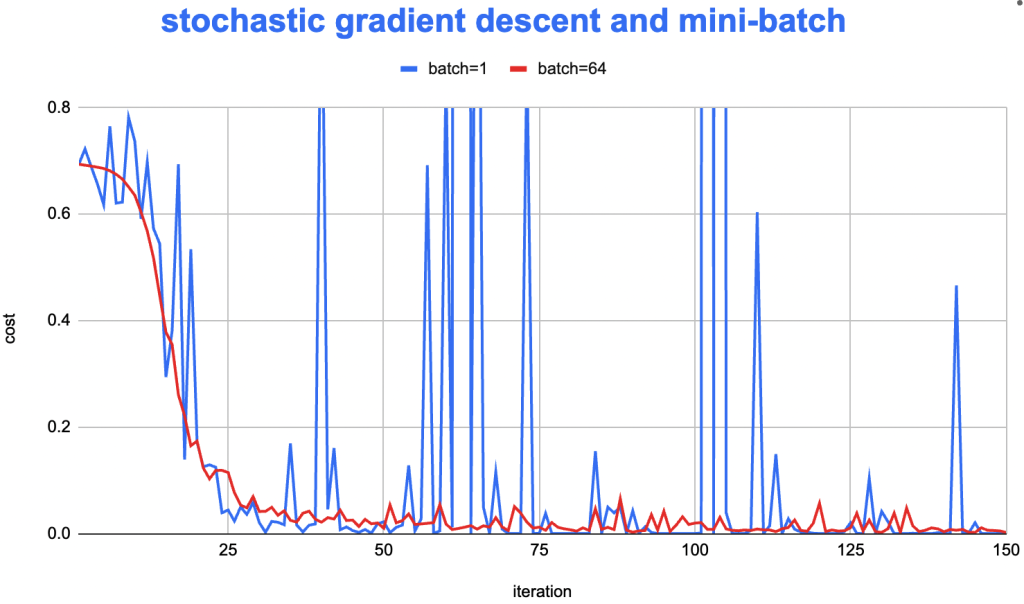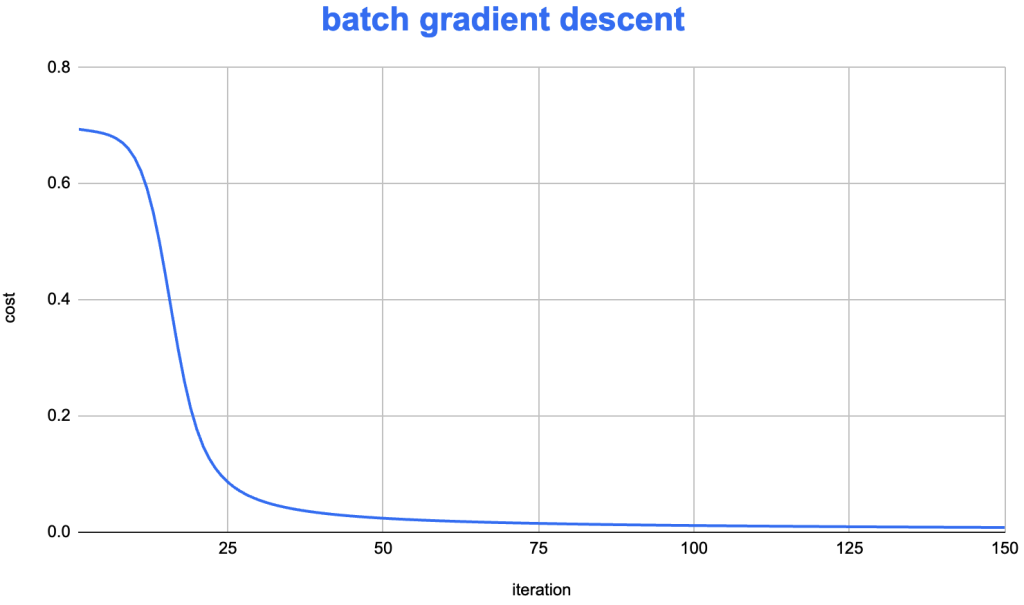目录
Mini-batch Gradient Descent的主要想法
在前面的实践中,使用“Gradient Descent”时,都是一次性把所有的数据集都考虑进去,一切似乎都没有什么问题。
但是,在现实实践中,如果训练数据量非常大,这种方式就不适用了。试想,在前面的示例中,输入样本数据,即\( X \)(或者 \( A^{[0]}\)),其维度(或者说shape)则可能是\( 300 \times 10,000,000 \)。这会导致每一次的梯度计算量都非常大,一次迭代(epoch)的时间会很长。
一种非常常见的、也是非常经典的梯度下降改进,就是 mini-batch gradient descent。首先,将样本分层若干小份,并单独对每个“小份”进行“Gradient Descent”,最后逐步完成所有样本的训练。完成一次所有样本的遍历,称之为一次迭代epoch。
在神经网络的训练中,可以用下面步骤理解这个过程:
for "a-small-batch-of-samples X^{t} " in "all-samples"
forward propagation on X^{t}
backward propagation on X^{t}
update W/b
W^{[l]} = W^{[l]} - lr * dW^{[l]}
b^{[l]} = b^{[l]} - lr * db^{[l]}相对于 mini-batch gradient descent ,前面介绍的一次把所有样本都用于训练的方法,也被称为“batch gradient descent”。
Stochastic Gradient Descent
在 mini-batch 中,如果每次批量的样本大小是 1 的话,那么,也称为Stochastic Gradient Descent(简称 SGD,随机梯度下降)。事实上,自开始使用 Backpropagation 算法以来,SGD就被用于提升神经网络的训练的效率。并且很快的,mini-batch gradient descent 就作为一种优化被使用。目前,mini-batch gradient descent 依旧是一种常用神经网络训练方法[1][2]。
收敛稳定性预估
不难想象,在“batch gradient descent”中,一次性把所有数据都用于梯度下降的算法,通常都能够获得更好的收敛速度。而在使用 mini-batch 的时候,由于不同的批次的样本在计算时,“计算梯度”都与“全局梯度”有一定的偏差,并且有时候偏差较大,有时候较小,所以,相比之下,收敛速度要慢一些。而,Stochastic Gradient Descent 则可能会更慢一些。
可以这么理解, mini-batch 和 Stochastic Gradient Descent 都总是使用一个局部的梯度(部分样本的梯度)来预估整体的梯度方向,自然效果会差一些。
这里我们改进了原来的神经网络实现 ssnn_bear.py,将其更新为使用 mini-batch 的 ssnn_cat.py。详细代码可以参考GitHub仓库:super simple neural network 。
运行 ssnn_cat.py 并观察 mini-batch 的 cost 下降速度如下:
mini-batch 迭代下cost总是在上下波动

batch gd算法下cost下降非常稳定

batch_size 大小的配置
一些经验数值可能是64、128、256、512等。Mini-batch 需要在大数据量和向量化计算之间取得一个平衡,所以通常需要更具训练的设备选择合适的 batch 大小,使得每次迭代都充分利用硬件的资源。
代码实现
在前述的神经网络上(参考),再做了一些修改,实现了 Mini-Batch 或者随机梯度下降。
新增 batch 大小参数
首先,新增了 batch_size 参数表示,同时增加对应参数 batch_iteration 表示,在一次样本迭代中,总计需要循环多少次。所以,这两个参数有如下关系:
batch_iteration = math.ceil(m/batch_size)对每批次样本做迭代
batch_iteration = math.ceil(m/batch_size)
...
for i in range(iteration_count):
for i_batch in range(batch_iteration):
...
# sample from i_batch*batch_size
batch_from = i_batch*batch_size
batch_to = min((i_batch+1)*batch_size,m)
batch_count = batch_to - batch_from
A0 = X[:,batch_from:batch_to] # column [batch_from,batch_to)
Y_L = Y[:,batch_from:batch_to] # Y_label [batch_from,batch_to)
...代码的其他地方,几乎不需要太大的改动。完整的代码参考:ssnn_cat.py
参考
- [1] Stochastic gradient descent
- [2] https://github.com/orczhou/ssnn/blob/main/ssnn_cat.py
- [3] https://github.com/orczhou/ssnn/blob/main/ssnn_bear.py
- [4] https://github.com/orczhou/ssnn
这是一个系列文章包含了,完整的文章还包括:
Leave a Reply